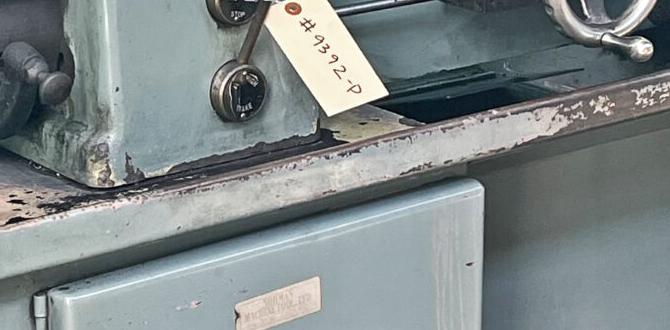Wood lathe installation mistakes can be costly, not just in terms of financial repercussions but also in potential safety hazards. Ensuring your wood lathe is set up correctly is paramount for both the longevity of your machine and the quality of your woodworking projects. From initial placement to the final securing of components, each step demands careful attention. Ignoring proper installation procedures can lead to vibrations, inaccurate cuts, premature wear on parts, and in severe cases, accidents. This guide will walk you through common pitfalls and provide clear, actionable advice to help you avoid them.
Foundation and Stability: The Bedrock of Proper Installation
The first and arguably most critical aspect of wood lathe installation is establishing a solid foundation. A lathe, by its very nature, generates significant rotational force and vibration. If your lathe isn’t placed on a stable, level surface, these vibrations can amplify, leading to a cascade of problems.
Common Mistakes and How to Avoid Them:
Uneven Flooring: Placing a lathe on an uneven concrete floor, for instance, without any leveling measures is a recipe for disaster. The machine will wobble, leading to inaccurate turning and excessive stress on bearings.
Solution: Use shims or leveling feet specifically designed for machinery. Many industrial floor systems have built-in leveling capabilities, but for home workshops, a good set of adjustable machine feet is invaluable. Ensure all feet are making firm contact with the floor.
Insecure Mounting: While some smaller benchtop lathes can operate effectively on a sturdy workbench, larger floor-standing models often benefit from being bolted down. Failing to secure a heavy lathe can cause it to shift during operation, posing a significant safety risk.
Solution: If your lathe has pre-drilled mounting holes, use them. Anchor bolts or lag screws are suitable for securing the lathe to a concrete floor. Ensure the mounting points are robust enough to withstand the forces generated during turning.
Insufficient Workspace: Overlooking the need for ample clearance around the lathe is another common oversight. You need space to move tools, feed stock, and, crucially, to step back and observe your work safely.
Solution: Plan your workshop layout with the lathe’s intended position in mind. Ensure there’s at least 2-3 feet of clear space around the machine on all sides, and more in front of the headstock and tailstock for longer pieces.
Power and Connectivity: Supplying the Lifeblood
The power supply for your wood lathe needs to be robust, correctly wired, and safely managed. Incorrect electrical connections are not only a fire hazard but can also damage the lathe’s motor and controls.
Common Mistakes and How to Avoid Them:
Incorrect Voltage/Amperage: Connecting a lathe designed for a specific voltage or amperage to an inadequate power source can lead to overheating, motor strain, and failure.
Solution: Always check the lathe’s specifications plate or manual to determine the required voltage and amperage. Ensure your workshop’s electrical system can meet these demands. Using an extension cord that is too thin or too long can also cause voltage drop, impacting performance.
Improper Grounding: A properly grounded machine is essential for electrical safety. A lack of grounding can lead to electrical shock if a fault occurs.
Solution: Ensure the power outlet you’re using is properly grounded. If you’re hardwiring the lathe, ensure the grounding wire is correctly connected according to local electrical codes.
Untidy Cabling: Loose, dangling power cords and cables are a tripping hazard and can get snagged by rotating workpieces or the lathe itself.
Solution: Use cable management solutions like zip ties, cord wraps, or raceways to keep all wiring neat, secure, and out of the way.
Tool Rest and Tailstock Alignment: Precision is Key
The alignment of your tool rest and tailstock is critical for successful turning, especially when working with longer pieces or performing detailed work. Misalignment can result in uneven tapers, out-of-round stock, and a frustrating turning experience.
Common Mistakes and How to Avoid Them:
Improper Tool Rest Height: The tool rest should be positioned just slightly below the center line of the workpiece. If it’s too high, it can jam the chisel, causing kickback. If it’s too low, the tool will chatter and create a rough surface.
Solution: After mounting your workpiece, adjust the tool rest so it’s approximately 1/8 inch below the center line. Keep it as close to the workpiece as possible without touching it.
Tailstock Misalignment: For long spindles, the tailstock needs to be perfectly aligned with the headstock center. Even a slight deviation can cause the tailstock end of the workpiece to wobble.
Solution: Most lathes have alignment methods, often involving setting a dial indicator or using simple alignment bars. Consult your lathe’s manual for specific instructions. Regularly check alignment, especially after moving the lathe.
Wood Lathe Chuck Installation Mistakes: A Critical Component
The wood lathe chuck installation mistakes are a particularly dangerous area to overlook. The chuck is what holds your workpiece securely, and if it’s not mounted correctly, it can lead to catastrophic failure, sending the workpiece flying.
Common Mistakes and How to Avoid Them:
Incorrect Spindle Thread: Lathe spindles come with specific thread sizes and directions (left or right-hand threads). Trying to force a chuck onto the wrong spindle thread will damage both.
Solution: Always verify your lathe’s spindle thread size and hand before purchasing a chuck. The information is usually found in your lathe’s manual.
Insufficient Tightening: While you don’t want to overtighten, a chuck needs to be firmly secured to the spindle. A loose chuck is extremely dangerous.
Solution: Follow the manufacturer’s recommendation for tightening. Often, this involves hand-tightening and then using a tightening bar or wrench provided with the chuck. Ensure the chuck tightens in the direction that resists the rotation of the lathe.
Debris on Spindle Threads: Dust, metal filings, or old grease on the spindle threads can prevent the chuck from seating properly, leading to a slightly loose fit and potential vibration.
Solution: Before installing the chuck, thoroughly clean the spindle threads with a brush or lint-free cloth and a mild solvent if necessary. Ensure the threads are dry before mounting.
Not Using a Wood Insert Properly: If your chuck requires a wood insert for specific applications (like bowls), ensure it’s correctly sized and securely attached to the chuck jaws before mounting the workpiece.
Solution: Follow the chuck manufacturer’s instructions for using any adapters or inserts. A poorly seated insert can become dislodged under pressure.
Final Checks and Ongoing Maintenance
Once your lathe is installed, don’t consider the job done. Regular checks and maintenance are essential for continued safe and effective operation.
Vibration Testing: After installation, run the lathe at low speeds with no workpiece mounted to listen for unusual noises or excessive vibration. Also, test at higher speeds.
Fastener Check: Periodically check that all bolts and screws securing the lathe and its components are tight.
* Lubrication: Follow the manufacturer’s recommendations for lubricating moving parts to prevent wear and ensure smooth operation.
By being aware of these common wood lathe installation mistakes and taking a methodical approach, you can ensure your lathe is set up safely and effectively, allowing you to focus on the creative and rewarding aspects of woodworking. Remember, safety should always be your top priority.



